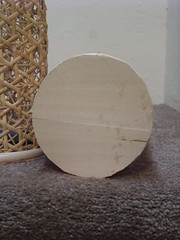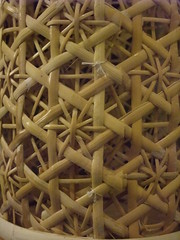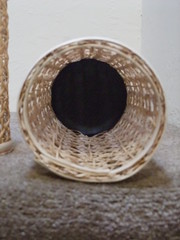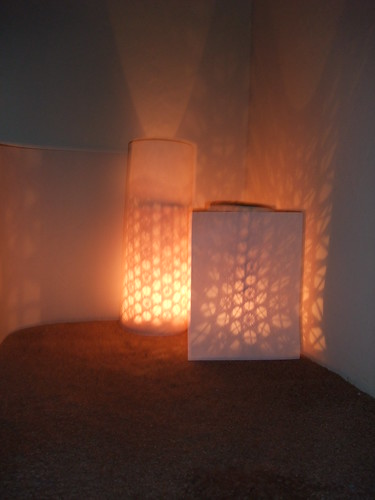Saionji Shonagon
New Member
 One dreamed of becoming somebody. Another remained awake and became. (Found in a fortune cookie.)
One dreamed of becoming somebody. Another remained awake and became. (Found in a fortune cookie.)
Posts: 7,240
|
Post by Saionji Shonagon on Sept 26, 2007 20:46:51 GMT -5
|
|
|
|
Post by dianet on Oct 9, 2007 0:02:36 GMT -5
Wow!! Nice link!!!
You know, I used to have this battery operated light that looked like a candle. If there was some way to make a paper lantern or perhaps one of the other ones, those lights would make a safe form of illumination while still giving the feel of a candle within.
But that's just the thought that went tumbling through my head.
|
|
bovil
New Member
 Fnord. Moo.
Fnord. Moo.
Posts: 411
|
Post by bovil on Oct 9, 2007 0:36:47 GMT -5
You know, I used to have this battery operated light that looked like a candle. If there was some way to make a paper lantern or perhaps one of the other ones, those lights would make a safe form of illumination while still giving the feel of a candle within. I've got a stack of battery-operated tea lights. They've got a LED set in a "flame" shaped plastic casting and a driver circuit that produces a very believable flicker when seen through just about any material that even slightly obscures a direct view. Only problem is they put out about as much light as a tea light. LEDtronics has a few LED candles that might put out enough light for a paper lantern. There's also a Phillips LED candle that's pretty clever. It may be worth checking out Smart Candle too. Nobody seems to want to talk about their light output in any real measurement, though. |
|
Saionji Shonagon
New Member
 One dreamed of becoming somebody. Another remained awake and became. (Found in a fortune cookie.)
One dreamed of becoming somebody. Another remained awake and became. (Found in a fortune cookie.)
Posts: 7,240
|
Post by Saionji Shonagon on Oct 9, 2007 8:21:47 GMT -5
I used LED tealights at GWW. They have solved the problem of the wimpy bulb-and-battery-pack that came with the original lanterns, but they don't put out a lot of light. flickr.com/photos/70104978@N00/1430066738/shows a shot at dusk from Coronet. Two lanterns were still running on the original bulbs and two with tea lights at this point. Lanterns with real votive candles on the table were used during the party to supplement them. More genius ideas as I come up with 'em. |
|
Saionji Shonagon
New Member
 One dreamed of becoming somebody. Another remained awake and became. (Found in a fortune cookie.)
One dreamed of becoming somebody. Another remained awake and became. (Found in a fortune cookie.)
Posts: 7,240
|
Post by Saionji Shonagon on Jan 25, 2008 20:06:20 GMT -5
There's a very nice article on the history of lanterns in issue# 24 of Daruma Magazine (the back issue I just acquired). The author is Kanebacko Masami of Nihon no Akari Museum, Obuse, Nagano prefecture. Cutting to the chase, the following described lighting systems were used prior to 1600: 1. Hobe (earthenware pots) are mentioned as early as 720 and hidebachi or matsutogai (stone pots) somewhat later. Both can be used to burn resinous pine wood for light and heat. 2. The taimatsu looks suspiciously like my bamboo wok scrubber. It's simply a torch made of bundled pine splits or twigs about 30" long. Reeds or straw could also be used. 3. The take-akare developed in Shinano, where pine does not do well. A piece of bamboo, ground at one end would be lit, and perhaps threaded through a hole in a metal stand to provide light. Evidently bamboo ash stalks are not prone to falling over, so they were considered a good, safe light source. 4. Todai or oil lamps are the ones Solveig-hime mentioned. They show up in 12th century picture scrolls of scenes of court life, such as the Genji Monogatari Emaki. The fuel could be fish oil, animal fat, rapeseed oil, perilla oil or even kusuzo (kerosene) oil from Echigo, which was known as early as the 7th century. Picture a tall candlestick with a dish at the top and a wick. The musubi todai is supposed to be the earliest form. It's basically three sticks tied together into a tripod, supporting an oil dish. A horyuji todai such as the one owned by Horyuji Temple near Nara has a reflector behind the oil dish. It's not clear in the article how old this style actually is, but the example shown in the magazine is from the Edo period. 5. Shokudai or candlesticks are said to date from the Kamakura period. Candles were more expensive than oil, but produced brighter light. www.shirakami.or.jp/~goshou01/SHOKUDAI.jpg6. Chochin date to the late 16th century. (Paper pasted to spirals of bamboo, baby!!!) The older forms are more cylindrical than round, though, such as the hako-chochin at the right of this picture: www.pingmag.jp/images/article/cho-chin10.jpgand the yumihari chochin on this page: www.edocraft.com/products/onda/products.html |
|
Saionji Shonagon
New Member
 One dreamed of becoming somebody. Another remained awake and became. (Found in a fortune cookie.)
One dreamed of becoming somebody. Another remained awake and became. (Found in a fortune cookie.)
Posts: 7,240
|
Post by Saionji Shonagon on Feb 1, 2008 23:15:56 GMT -5
|
|
Saionji Shonagon
New Member
 One dreamed of becoming somebody. Another remained awake and became. (Found in a fortune cookie.)
One dreamed of becoming somebody. Another remained awake and became. (Found in a fortune cookie.)
Posts: 7,240
|
Post by Saionji Shonagon on Feb 23, 2009 21:38:58 GMT -5
I've been thinking about the lantern situation. The paper Cost Plus lanterns aren't exactly period, however, many of the period lighting solutions found in Japanese homes and encampments will NOT pass muster in terms of fire safety. Paper lanterns say "Hey, we're being Japanese here" to the average event-goer and if flame is a concern, they'll hide an LED light source satisfactorily. Still, my inner authenticist has wanted to explore whether there was a better way. I've found written descriptions in several places that the paper chochin evolved from simple baskets with candles or oil-and-wick dishes inside them and FINALLY found an image here. pingmag.jp/2007/02/22/lantern/  I've never done basket weaving. Ever. And a preliminary search of ikebana supplies was financially discouraging. However, there is a caning supply shop in Berkeley and a stroll through their website tells me that they have pre-woven cane webbing for chair seat repairs that looks something like the openwork on the basket at left. www.caningshop.com/Merchant2/merchant.mvc?Screen=CTGY&Category_Code=CHR-A2I'd love to find better evidence to corroborrate the PingMag article/photo, if at all possible, but it's a start. |
|
|
|
Post by crimsongriffin28 on Feb 25, 2009 6:13:51 GMT -5
Well, thanks for that! Now I know what kind fo swag to shop for if I make Pennsic this year. I always try to bring a few chochin with me, but as I was unwilling to pay for outdoorsy ones treated with persimmon or whatnot, the humidity/dew did the glue on the ribs in by the end of two weeks. Feh. Tourist junk. You really get what you pay for.
Personally, I am fond of the red ones your find at temples or outsife nomiya. But often even these have a waterproof cover to shield them and make them last years. Plus it's electric lighting. I also doubt the red ones are period, I'm just fond of the color.
There's a coupla places I have in mind though, in Asakusa and Kyoto. Very traditional handicrafts. Got a hundred dollar persimon treated kasa in the shop in Kyoto, and worth every yen too. Almost too beautiful for Pennsic drudgery...
|
|
Saionji Shonagon
New Member
 One dreamed of becoming somebody. Another remained awake and became. (Found in a fortune cookie.)
One dreamed of becoming somebody. Another remained awake and became. (Found in a fortune cookie.)
Posts: 7,240
|
Post by Saionji Shonagon on Mar 29, 2009 17:02:17 GMT -5
 Materials: pre-woven cane webbing, flat oval reed, craft plywood, wood glue, thread, 5" metal candle plates. Cane webbing and reed can be purchased online from The Caning Shop. www.caningshop.com/Merchant2/merchant.mvc?Screen=CTGY&Category_Code=CHR-AThey also carry gourds and gourd cutting tools for anyone contemplating a suito (samurai's gourd canteen. The basket bottom was constructed by gluing and clamping a piece of cane into a circle. Once dry, two pieces of thin craft plywood were glued to the bottom - two pieces because they came in a sheet 1/32" x 3" x 24" wide and the diameter is roughly 5" so a metal candle dish can sit inside it. Once that was dry, the excess was trimmed away with a craft saw.   Raw edges of the pre-woven cane were stabilized with masking tape, then cut. A utility knife would've dragged too many of the fine pieces out of alightment, so I used the shears I keep for random dubious craft projects not involving fabric. The tape was removed, glue was applied to the inside of one edge, then the cane was curled into a tube and tied closed with thread.  The lip of the basket bottom was given an application of glue and the tube fitted inside it. Another section of cane was treated with glue and curled into another circle inside the tube and fitted into the basket bottom. A couple of bamboo skewers trimmed to size were used to hold the inner ring of cane against the woven cane and outer ring until the glue was dried. Similar applications of cane and glue were done to the top of the basket. This bonus find at San Francisco's Asian Art Museum, a flower basket from the Muromachi period that uses a decorative hexagonal weave not unlike that used in chair caning www.flickr.com/photos/70104978@N00/3388403099/in/set-72157615959651100/Because these have to not give SCA fire wardens hissy fits, I fitted 5" diameter metal candle plates into the bottom of each basket. I figure I have the option of a votive candle inside a glass cup or a battery powered LED, depending upon field conditions.  Titebond II is an excellent wood glue, however, it's not white and it dries darker than the cane. I will probably sand lightly and maybe paint a thin coat of glue on the cane edges to even them up. Paper will eventually be glued to the outside of each basket. I'm still contemplating handle design. |
|
|
|
Post by mrcunningham on Mar 30, 2009 15:57:30 GMT -5
Jeebus, that's pretty.
|
|
Saionji Shonagon
New Member
 One dreamed of becoming somebody. Another remained awake and became. (Found in a fortune cookie.)
One dreamed of becoming somebody. Another remained awake and became. (Found in a fortune cookie.)
Posts: 7,240
|
Post by Saionji Shonagon on Mar 30, 2009 17:25:02 GMT -5
I think tonight I need to wrap one in plain sumi-e paper and one in the synthetic shoji material, put candles in each, light 'em and turn the lights out.....
|
|
Saionji Shonagon
New Member
 One dreamed of becoming somebody. Another remained awake and became. (Found in a fortune cookie.)
One dreamed of becoming somebody. Another remained awake and became. (Found in a fortune cookie.)
Posts: 7,240
|
Post by Saionji Shonagon on Mar 30, 2009 22:31:49 GMT -5
 Kaga-chochin paper test. On the left, Synskin fiberglass shoji "paper." On the right, plain old sumi-e paper. The Synskin is heavier, water resistant and recommended by the seller for lamp shades and lighting. As I plan to keep any live flame inside a votive cup or chimney when used with these lanterns, I think it should be safe. It wins. Tap Plastics sells it by the foot. www.tapplastics.com/shop/product.php?pid=241 |
|
|
|
Post by Noriko on Mar 30, 2009 22:39:30 GMT -5
Eeeee! Pretty!
|
|
|
|
Post by Imagawa Tadamori on Mar 31, 2009 10:59:13 GMT -5
Outstanding work on the lanterns, Makiwara-hime! You never fail to impress when you tackle such projects. Because these have to not give SCA fire wardens hissy fits, I fitted 5" diameter metal candle plates into the bottom of each basket. I figure I have the option of a votive candle inside a glass cup or a battery powered LED, depending upon field conditions. Soooo... this would be a good time to say "look what I found for you?"  www.mrlightcandles.com/home.php www.mrlightcandles.com/home.php- Imagawa |
|
Saionji Shonagon
New Member
 One dreamed of becoming somebody. Another remained awake and became. (Found in a fortune cookie.)
One dreamed of becoming somebody. Another remained awake and became. (Found in a fortune cookie.)
Posts: 7,240
|
Post by Saionji Shonagon on Mar 31, 2009 11:13:07 GMT -5
Soooo... this would be a good time to say "look what I found for you?"  LEDs I got. Live candles still throw more light, so having the option to use both was part of my design concept. |
|